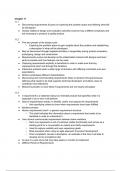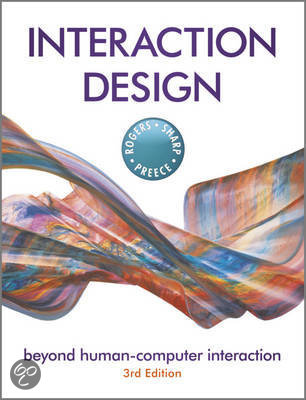Chapter 11
11.1
● Discovering requirements focuses on exploring the problem space and defining what will
be developed
● Closely related to design and evaluation activities however has a different emphasis and
are necessary to produce a quality product
11.2
● First two phases of the design cycle
○ Exploring the problem space to gain insights about the problem and establishing
a description of what will be developed
● May be discovered through targeted activities or tangentially during product evaluation,
prototyping, design and construction
● Requirements evolve and develop as the stakeholders interact with designs and learn
what is possible and how features can be used.
● Capturing requirements explicitly is beneficial in order to make sure that key
requirements aren’t lost through the iterations
● Interactive products span a wide range of domains with differing constraints and user
expectations
● Notions emphasise different characteristics
● Discovering and communicating requirements helps to advance this goal because
defining what needs to be built supports technical developers and allows users to
contribute more effectively
● Miscommunication is more likely if requirements are not clearly articulated
11.3
● A requirement is a statement about an intended product that specifies what it is
expected to do or how it will perform
● Goal of requirements activity: to identify, clarify, and capture the requirements
○ Also specifying criteria to know when requirements have been fulfilled
● Iterative process
● Atomic requirements shell = a generic requirement structure
○ This shell indicated the information about a requirement that needs to be
identified in order to understand it
● User stories communicate requirements between team members
○ Each one represents a unit of customer-visible functionality and serves as a
starting point for a conversation to extend and clarify requirements
○ Used to capture usability and user experience goals
○ Most prevalent when using an agile approach to product development
○ Once completed: include a description, an estimate of the time it will take to
develop and an acceptance test
● An epic is a user story that may take weeks or months to implement
● Different Kinds of Requirements
, ○ Different sources: user community, business community, as a result of technology
to be applied
○ Functional requirements = what the product will do and the characteristics
(constraints) of the product
○ Nonfunctional requirement = other type of requirement (ie. video game can be
played on a variety of platforms)
○ Suzanne and James Robertson categorised list:
■ Project Drivers, Project Constraints, Functional Requirements,
Nonfunctional Requirements, Project Issues
○ Ellen Gottesdiener and Mary Gorman
■ Created a list of 7 product dimensions
■ User, Interface, Action, Data, Control, Environment, Quality Attribute
○ Six most common types of requirements: Functional, data, environment, user,
usability and user experience
○ Functional requirement
■ Capture what the product will do
○ Data requirement
■ Captures the type, volatility, size/amount, persistence, accuracy and value
of the required data
○ Environmental requirements
■ The circumstances in which the interactive product will operate
■ Four aspects of the environment lead to different types of requirements
● Physical environment = how much lighting, noise, movement and
dust is expected in the operational environment (ie. speech
interface at an ATM is problematic as it’s a busy environment)
● Social environment = issues regarding the social aspects of
interaction design such as collaboration and coordination
● Organisational environment = how good is user support likely to
be, how easily can it be obtained and are there facilities or
resources for training, how efficient or stable is the
communications infrastructure etc.
● Technical environment = what technologies will the product run on
or need to be compatible with etc.
○ User characteristics
■ Captures the key attributes of the intended user group
■ User profile = the collection of characteristics for a typical user
○ Usability goals and user experience goals
■ Should be captured together
■ Usability engineering = an approach in which specific measures for the
usability goals of the product are agreed upon early in the development
process and are used to track progress as development proceeds
■ Important to understand the importance of user experience goals (even if
it’s harder to identify quantifiable measures)





